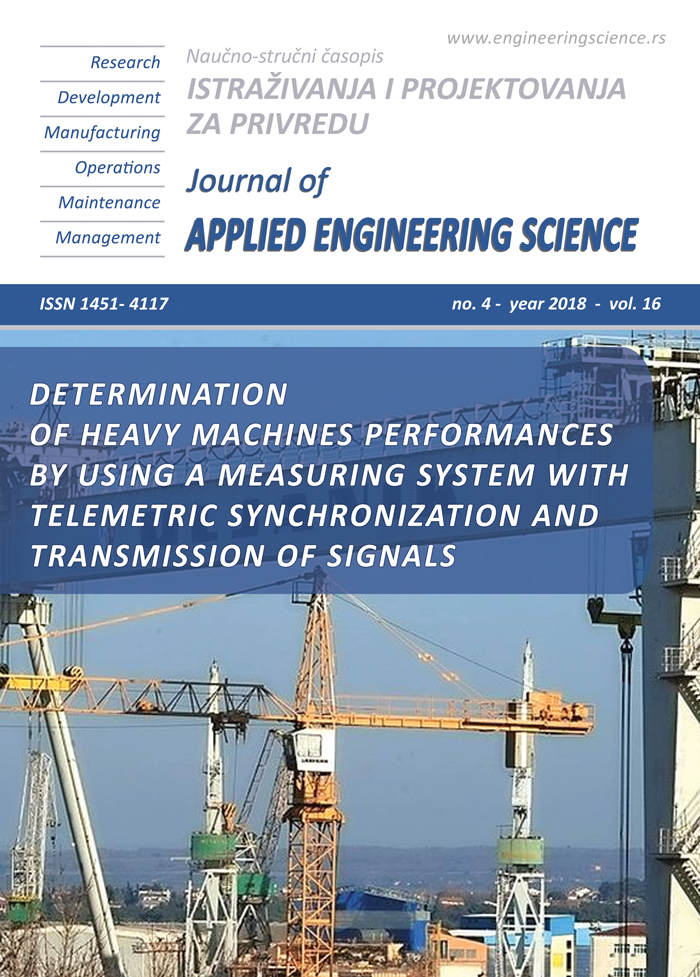REVIEW OF THE BIG DATA TECHNOLOGY USE IN THE MEDICAL PROGNOSIS
Abstract
The article shows the main aspects and problematics of elaborating effective models of current diagnostics and diagnostic prognosis of the patient’s health status, who is an object of non–invasive monitoring, based on the current analysis of characteristic combinations of his/her vital signs on nosology and the results of long–term collecting, processing and semantic classificating the biomedical data.
References
Drowning in Big Data? Reducing Information Technology Complexities and Costs for Healthcare Organizations. (2012). Frost & Sullivan, from https://www.emc.com/collateral/analyst–reports/frost–sullivan–reducing–information–technology–complexities–ar.pdf, accessed on 2018-09-20.
Song, Z., Liu, C.H., Wu, J., Ma, J., Wang, W. (2014). QoI–aware multi–task–oriented dynamic participant selection with budget constraints. IEEE Transactions on Vehicular Technology, vol. 63, no. 9, 4618-4632, DOI: 10.1109/TVT.2014.2317701
Banaee, H., Ahmed, M.U., Loutfi, A. (2013). Data mining for wearable sensors in health monitoring systems: A review of recent trends and challenges. Sensors, vol. 13, no. 12, 17472-17500, DOI: 10.3390/s131217472
Rathi, M., Narasimhan, B. (2017). Data Mining, Soft Computing, Machine Learning and BioInspired Computing for Heart Disease Classification/Prediction – A Review, DOI: 10.23956/ijarcsse/V7I4/0156
Poon, C.C., Lo, B.P., Yuce, M.R., Alomainy, A., Hao, Y. (2015). Body sensor networks: In the era of big data and beyond. IEEE Reviews in Biomedical Engineering, vol. 8, 4-16, DOI: 10.1109/RBME.2015.2427254
Raghupathi, W., Raghupathi, V. (2014). Big data analytics in healthcare: promise and potential. Health Information Science and Systems, no. 2, 3, DOI: 10.1186/2047-2501-2-3
Yicuan, W., Terry, L., Terry, K., Byrd, A. (2015). Big data analytics: Understanding its capabilities and potential benefits for healthcare organizations. Technological Forecasting and Social Change, vol. 126, 3-13, DOI: https://doi.org/10.1016/j.techfore.2015.12.019
Zeinab Arabasadi, Roohallah Alizadehsani, Mohamad Roshanzamir, Hossein Moosaei. (2017). Computer aided decision making for heart disease detection using hybrid neural network–Genetic algorithm. Computer Methods and Programs in Biomedicine, vol. 141, 19-26, DOI: 10.1016/j.cmpb.2017.01.004
Blake, C., Merz, C. (1998). UCI Repository of Machine Learning Databases. University of California, Department of Information and Computer Science, Irvine.
Acharya, U.R., Fujita, H., Oh, S.L., Hagiwara, Y., Tan, J.H., Adam, M. (2017). Application of deep convolutional neural network for automated detection of myocardial infarction using ECG signals. Information Sciences, vol. 415-416, 190-198, DOI: https://doi.org/10.1016/j.ins.2017.06.027
Goldberger, A.L., Amaral, L.A.N., Glass, L., Hausdorff, J.M., Ivanov, P.C.H., Mark, R.G., Mietus, J.E., Moody, G.B., Peng, C.K., Stanley, H.E. (2000). PhysioBank, PhysioToolkit, and PhysioNet: Components of a new research resource for complex physiologic signals. Circulation, vol. 101, no. 23, e215-e220, DOI: 10.1161/01.CIR.101.23.e215
Noorian, A., Dabanloo, N.J., Parvaneh, S. (2014). Detection and localization of myocardial infarction using K–nearest neighbor classifier. Conference “Computing in Cardiology 2014”.
Sakr, S., Elshawi, R., Ahmed, A., Qureshi, W.T., Brawner, C., Keteyian, S., Blaha, M.J., Al-Mallah, M.H. (2017). Using machine learning on cardiorespiratory fitness data for predicting hypertension: The Henry Ford ExercIse Testing (FIT) Project. PLoS ONE, vol. 13, no. 4, e0195344, DOI: https://doi.org/10.1371/journal.pone.0195344
Al–Mallah, M.H., Keteyian, S.J., Brawner, C.A., Whelton, S., Blaha, M.J. (2014). Rationale and design of the Henry Ford Exercise Testing Project (the FIT project). Clinical Cardiology, vol. 37, no. 8, 456-461, DOI: https://doi.org/10. 1002/clc.22302
Kurgan, L., Cios, K.J. (2001). Discretization algorithm that uses class-attribute interdependence maximization. Proceedings of the 2001 International Conference on Artificial Intelligence, p. 980-987.
Kent, J.T. (1983). Information gain and a general measure of correlation. Biometrika, vol. 70, no. 1, 163-173, DOI: https://doi.org/10.1093/biomet/70.1.163
Guyon, I., Elisseeff, A. (2003). An introduction to variable and feature selection. Journal of Machine Learning Research, no. 3, 1157-1182, DOI: 10.1162/153244303322753616
Beltrame, T., Amelard, R., Wong, A., Hughson, R.L. (2017). Prediction of oxygen uptake dynamics by machine learning analysis of wearable sensors during activities of daily living. Scientific Reports, no. 7, 45738, DOI: 10.1038/srep45738
Webster, E., Sukaviriya, N., Chang, H.-Y., Kozloski, J. (2017). Predicting cognitive states from wearable recordings of autonomic function. IBM Journal of Research and Development, vol. 61, no. 2/3, 2:1-2:11, DOI: 10.1147/JRD.2017.2648698
Apache Hadoop, from http://hadoop.apache.org/, accessed on 2018-09-21.
Chen, M., Ma, Y., Song, J., Lai, C.-F., Hu, B. (2016). Smart clothing: Connecting human with clouds and big data for sustainable health monitoring. Mobile Networks and Applications, vol. 21, no. 5, 825-845, DOI: https://doi.org/10.1007/s11036–016–0745–1

